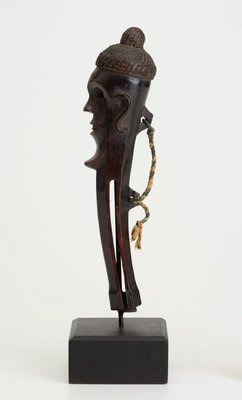


-
Details
- Other Title
- Musket ball holder
- Place where the work was made
-
North Sumatra
→
Indonesia
- Cultural origin
- Karo Batak
- Date
- 19th century
- Media category
- Arms & armour
- Materials used
- wood and rattan
- Dimensions
- 21.2 x 4.8 x 5.1 cm
- Credit
- Christopher Worrall Wilson Bequest 2010
- Location
- Not on display
- Accession number
- 528.2010
- Copyright
- Share
-
-
About
The Batak people of North Sumatra inhabit the mountainous interior region centring round Lake Toba. The Lake and Samosir Island on the lake are at the heart of Batak activities and culture. Aside from the Toba group, the Batak identify themselves as belonging to five other distinct communities. The Pakpak live west of the lake, the Karo are north-west and the Simalungun are east of the lake. The Angkola and Mandailing Batak who do not share their borders with the lake are further south and in closer proximity to the Indian Ocean. Whilst the Batak have long maintained trading links with coastal communities, especially along the Strait of Malacca,their relative isolation meant that they did not experience direct contact with Europeans until the mid 19th century when they were introduced to Christianity by Dutch missionaries. Whilst most Batak villagers converted to the new monotheistic religion they never entirely abandoned their pre-Christian animist cosmologies and as a result some interesting and syncretic religious practises were established.
Carved from buffalo horn and wood, this type of clip was used by Karo Batak warriors and hunters to hold round lead bullets. More generally
referred to as paru-paru, such accessories are also known in the Batak language as 'baba ni onggang'or ‘beak of the hornbill’, because of their avianappearance when viewed from the side.This example exhibits an elongated and stylised human face with strong aquiline features and a rattan cap. This imagery is characteristic of the anthropomorphic Bataksculptures used to communicate with ancestors
and ward off spirits and demonic forces. The exaggerated proportions of the head and face reflect the Batak belief that the tondi soul or
life-force resides in the human head. -
Exhibition history
Shown in 1 exhibition
Glorious, Art Gallery of New South Wales, Sydney, 27 May 2017–06 Jan 2019
-
Bibliography
Referenced in 1 publication
-
Niki van den Heuvel, Ancestral art of the Indonesian archipelago, Sydney, 2017, 68 (colour illus.).
-
-
Provenance
J.J. Klejman Gallery, pre 1955, New York/United States of America
Sam Dubiner, 1955-1998, New York/United States of America, purchased from J.J. Klejman Gallery. Sam Dubiner migrated to Israel and the object was displayed at the Tel Aviv Museum until 1998.
Wayne Heathcote Gallery, 1998, Australia
Mariann Ford, 1998-Dec 2010, Sydney/New South Wales/Australia, purchased from Wayne Heathcote through Gabriella Roy at Aboriginal and Pacific Art Gallery (art dealership), Sydney. Gift to the Art Gallery of New South Wales as part of the Christopher Worrall Wilson Bequest 2010.
